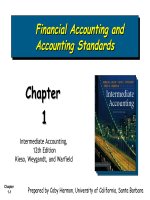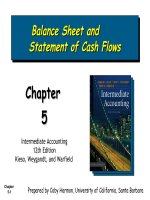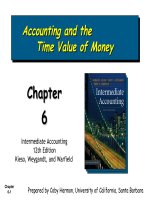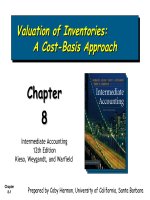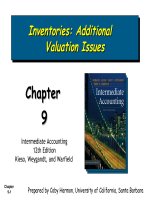Intermediate accounting IFRS edtion kieso weygrant warfield chapter 15
Bạn đang xem bản rút gọn của tài liệu. Xem và tải ngay bản đầy đủ của tài liệu tại đây (1.21 MB, 79 trang )
15-1
PREVIEW OF CHAPTER
15
Intermediate Accounting
IFRS 2nd Edition
Kieso, Weygandt, and Warfield
15-2
15
Equity
LEARNING OBJECTIVES
After studying this chapter, you should be able to:
1. Discuss the characteristics of
the corporate form of
organization.
2. Identify the key components of equity.
3. Explain the accounting procedures for
issuing shares.
4. Describe the accounting for treasury
shares.
15-3
5. Explain the accounting for and
reporting of preference shares.
6. Describe the policies used in
distributing dividends.
7. Identify the various forms of dividend
distributions.
8. Explain the accounting for share
dividends and share splits.
9. Indicate how to present and analyze
equity.
CORPORATE FORM OF ORGANIZATION
Three primary forms of business organization.
Proprietorship
Partnership
Corporation
Special characteristics of the corporate form:
1.Influence of corporate law.
2.Use of the share system.
3.Development of a variety of ownership interests.
15-4
LO 1
CORPORATE FORM OF ORGANIZATION
Corporate Law
15-5
Corporation must submit articles of incorporation to the
appropriate governmental agency for the country in which
incorporation is desired.
Governmental agency issues a corporation charter.
Advantage to incorporate where laws favor the corporate
form of business organization.
LO 1
CORPORATE FORM OF ORGANIZATION
Share System
In the absence of restrictive provisions, each share carries
the following rights:
1.To share proportionately in profits and losses.
2.To share proportionately in management (the right to vote
for directors).
3.To share proportionately in assets upon liquidation.
4.To share proportionately in any new issues of shares of
the same class—called the preemptive right.
15-6
LO 1
CORPORATE FORM OF ORGANIZATION
Variety of Ownership Interests
Ordinary shares represent the residual corporate interest.
Bears
ultimate risks of loss.
Receives
Not
the benefits of success.
guaranteed dividends nor assets upon dissolution.
Preference shares are created by contract, when shareholders’
sacrifice certain rights in return for other rights or privileges,
usually dividend preference.
15-7
LO 1
15
Equity
LEARNING OBJECTIVES
After studying this chapter, you should be able to:
1. Discuss the characteristics of the
corporate form of organization.
5. Explain the accounting for and
reporting of preference shares.
2. Identify the key components of
equity.
6. Describe the policies used in
distributing dividends.
3. Explain the accounting procedures for
issuing shares.
4. Describe the accounting for treasury
shares.
15-8
7. Identify the various forms of dividend
distributions.
8. Explain the accounting for share
dividends and share splits.
9. Indicate how to present and analyze
equity.
EQUITY
Equity is often subclassified on the statement of financial
position into the following categories
1.Share capital.
2.Share premium.
3.Retained earnings.
4.Accumulated other comprehensive income.
5.Treasury shares.
6.Non-controlling interest (minority interest).
15-9
LO 2
EQUITY
Ordinary Shares
Contributed
Capital
Account
Share Premium
Account
Preference Shares
Account
Two Primary
Sources of
Equity
Retained Earnings
Account
Less:
Treasury Shares
Assets –
Liabilities =
Equity
Account
15-10
LO 2
15
Equity
LEARNING OBJECTIVES
After studying this chapter, you should be able to:
15-11
1. Discuss the characteristics of the
corporate form of organization.
5. Explain the accounting for and
reporting of preference shares.
2. Identify the key components of equity.
6. Describe the policies used in
distributing dividends.
3. Explain the accounting
procedures for issuing shares.
7. Identify the various forms of dividend
distributions.
4. Describe the accounting for treasury
shares.
8. Explain the accounting for share
dividends and share splits.
9. Indicate how to present and analyze
equity.
EQUITY
Issuance of Shares
Accounting problems involved in the issuance of shares:
1.Par value shares.
2.No-par shares.
3.Shares issued in combination with other securities.
4.Shares issued in non-cash transactions.
5.Costs of issuing shares.
15-12
LO 3
EQUITY
Par Value Shares
Low par values help companies avoid a contingent liability.
Corporations maintain accounts for:
Preference
Share
15-13
Shares or Ordinary Shares.
Premium.
LO 3
EQUITY
No-Par Shares
Reasons for issuance:
Avoids contingent liability.
Avoids confusion over recording par value versus fair
market value.
A major disadvantage of no-par shares is that some countries levy
a high tax on these issues. In addition, in some countries the total
issue price for no-par shares may be considered legal capital,
which could reduce the flexibility in paying dividends.
15-14
LO 3
EQUITY
Illustration: Video Electronics Corporation is organized with
10,000 ordinary shares authorized without par value. If Video
Electronics issues 500 shares for cash at €10 per share, it
makes the following entry.
Cash
5,000
Share
Capital—Ordinary
5,000
Video Electronics issues another 500 shares for €11 per share.
Cash
5,500
Share
15-15
Capital—Ordinary
5,500
LO 3
EQUITY
Illustration: Some countries require that no-par shares have a
stated value. If a company issued 1,000 of the shares with a €5
stated value at €15 per share for cash, it makes the following
entry.
Cash
15,000
Share
Capital—Ordinary
5,000
Share
Premium—Ordinary
10,000
15-16
LO 3
EQUITY
Shares Issued with Other Securities
Two methods of allocating proceeds:
Proportional
Incremental
15-17
method.
method.
LO 3
EQUITY
BE15-4: Ravonette Corporation issued 300 shares of $10 par value
ordinary shares and 100 shares of $50 par value preference shares for
a lump sum of $13,500. The ordinary shares have a market value of
$20 per share, and the preference shares have a market value of $90
per share.
Proportional
Method
15-18
LO 3
EQUITY
BE15-4: Ravonette Corporation issued 300 shares of $10 par value
ordinary shares and 100 shares of $50 par value preference shares for
a lump sum of $13,500. The ordinary shares have a market value of
$20 per share, and the preference shares have a market value of $90
per share.
Journal entry (Proportional):
Cash
13,500
Share
Capital—Preference (100 X $50)
5,000
Share
Premium—Preference
15-19
3,100
LO 3
EQUITY
BE15-4 (Variation): Ravonette Corporation issued 300 shares of $10
par value ordinary shares and 100 shares of $50 par value preference
shares for a lump sum of $13,500. The ordinary shares have a market
value of $20 per share, and the value of preference shares are unknown.
Incremental
Method
15-20
LO 3
EQUITY
BE15-4 (Variation): Ravonette Corporation issued 300 shares of $10
par value ordinary shares and 100 shares of $50 par value preference
shares for a lump sum of $13,500. The ordinary shares have a market
value of $20 per share, and the value of preference shares are unknown.
Journal entry (Incremental):
Cash
13,500
Share
Capital—Preference (100 X $50)
5,000
Share
Premium—Preference
2,500
15-21
Share
LO 3
EQUITY
Shares Issued in Noncash Transactions
The general rule: Companies should record shares
issued for services or property other than cash at the
fair
If
15-22
value of the goods or services received.
the fair value of the goods or services cannot be
measured reliably, use the fair value of the shares
issued.
LO 3
EQUITY
Illustration: The following series of transactions illustrates
the procedure for recording the issuance of 10,000 shares of
€10 par value ordinary shares for a patent for Marlowe
Company, in various circumstances.
1. Marlowe cannot readily determine the fair value of the
patent, but it knows the fair value of the shares is €140,000.
Patent
140,000
Share
Capital—Ordinary
100,000
Share
15-23
Premium—Ordinary
LO 3
EQUITY
2. Marlowe cannot readily determine the fair value of the
shares, but it determines the fair value of the patent is
€150,000.
Patent
150,000
Share
Capital—Ordinary
100,000
Share
Premium—Ordinary
50,000
15-24
LO 3
EQUITY
3. Marlowe cannot readily determine the fair value of the
shares nor the fair value of the patent. An independent
consultant values the patent at €125,000 based on discounted
expected cash flows.
Patent
125,000
Share
Capital—Ordinary
100,000
Share
Premium—Ordinary
25,000
15-25
LO 3
